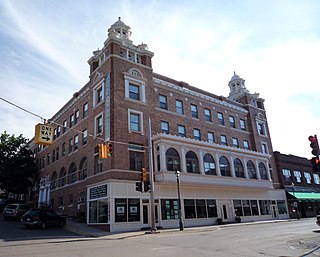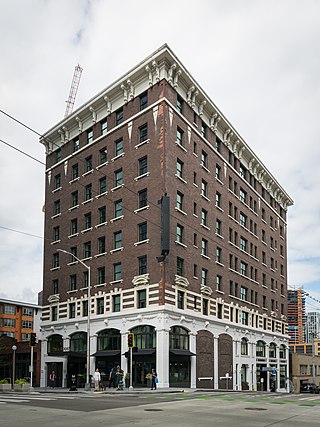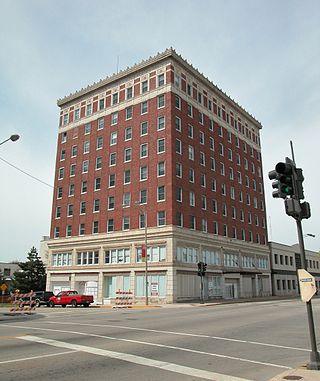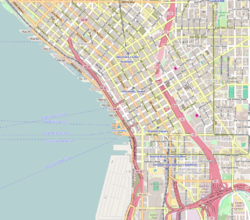
Pioneer Square is a neighborhood in the southwest corner of Downtown Seattle, Washington, US. It was once the heart of the city: Seattle's founders settled there in 1852, following a brief six-month settlement at Alki Point on the far side of Elliott Bay. The early structures in the neighborhood were mostly wooden, and nearly all burned in the Great Seattle Fire of 1889. By the end of 1890, dozens of brick and stone buildings had been erected in their stead; to this day, the architectural character of the neighborhood derives from these late 19th century buildings, mostly examples of Richardsonian Romanesque.

Klondike Gold Rush National Historical Park is a national historical park operated by the National Park Service that seeks to commemorate the Klondike Gold Rush of the late 1890s. Though the gold fields that were the ultimate goal of the stampeders lay in the Yukon Territory, the park comprises staging areas for the trek there and the routes leading in its direction. There are four units, including three in Municipality of Skagway Borough, Alaska and a fourth in the Pioneer Square National Historic District in Seattle, Washington.

The Pioneer Building is a Richardsonian Romanesque stone, red brick, terra cotta, and cast iron building located on the northeast corner of First Avenue and James Street, in Seattle's Pioneer Square District. Completed in 1892, the Pioneer Building was designed by architect Elmer Fisher, who designed several of the historic district's new buildings following the Great Seattle Fire of 1889.

The Union Trust Building is a commercial building in Seattle, Washington, United States. Located in the city's Pioneer Square neighborhood, on the corner of Main Street and Occidental Way South, it was one of the first rehabilitated buildings in the neighborhood, which is now officially a historic district. In the 1960s, when Pioneer Square was better known as "Skid Road", architect Ralph Anderson purchased the building from investor Sam Israel for $50,000 and set about remodeling it, a project that set a pattern for the next several decades of development in the neighborhood. Anderson also rehabilitated the adjacent Union Trust Annex.

The Alaska Building, which now houses the Courtyard by Marriott Seattle Downtown/Pioneer Square, is a 15-floor building in Seattle, Washington completed in 1904 to designs by St. Louis architects Eames and Young. At the time of its completion, it was the tallest building in the state of Washington—and remained so until the 1910 completion of Spokane's Old National Bank Building.

The Belcrest Apartments is an apartment building located at 5440 Cass Avenue in Midtown Detroit, Michigan. It was built in 1926 as the Belcrest Hotel, designated a Michigan State Historic Site in 1983, and listed on the National Register of Historic Places in 1984. It is significant as an early example of the apartment hotel development concept in Detroit, and a major early work of architect Charles N. Agree.

The Federal Office Building, Seattle, Washington is a historic federal office building located at Seattle in King County, Washington.

The Alaska Trade Building, also known as the Union Record Building and the Steele Building, is a historic building in Seattle, Washington located on First Avenue near the Pike Place Market. Built in 1909, it was one of the first reinforced steel, concrete and brick buildings in the area and was advertised as being completely fireproof. The building is historically associated with the country's only Union-owned daily newspaper, The Seattle Union Record and is listed on the National Register of Historic Places. The Butterworth Building, another National Register property, neighbors it to the north.

The Rockingham Hotel is a historic former hotel and contemporary condominium at 401 State Street in Portsmouth, New Hampshire, United States. Built in 1885, it is a prominent early example of Colonial Revival architecture, built in part in homage to Woodbury Langdon, whose 1785 home occupied the site. Langdon's home and the hotel both played host to leading figures of their day, and the hotel was one of the finest in northern New England. The hotel, now converted to condominiums, was added to the National Register of Historic Places in 1982.

The Bell Apartments, also known as the Austin A. Bell Building is a historic building located at 2324 1st Avenue in the Belltown neighborhood of Seattle Washington. The building was named for Austin Americus Bell, son of one of Seattle's earliest pioneers, but built under the supervision of his wife Eva following Bell's unexpected suicide in 1889 soon after proposing the building. It was designed with a mix of Richardsonian, Gothic and Italianate design elements by notable northwest architect, Elmer Fisher, who designed many of Seattle's commercial buildings following the Great Seattle fire.

The Colman Building is a historic office building on First Avenue in downtown Seattle, Washington. It occupies a half of a block in proximity to Pioneer Square, and is bound by First Avenue, Marion, and Columbia Streets. It is listed on the National Register of Historic Places and is a City of Seattle landmark.

The Holyoke Building is a historic building located in downtown Seattle, Washington. It is a substantial five story brick structure with stone trimmings. Construction began at the corner of First Avenue and Spring Streets just before the Great Seattle fire of 1889. Completed in early 1890, it was among the first permanent buildings completed and ready for occupancy in downtown Seattle following the fire. Today the Holyoke Building is one of the very few such buildings still standing in Seattle outside of the Pioneer Square district and is a historic remnant of the northward expansion of Seattle's business district between the time of the great fire and the Yukon Gold Rush in 1897.

The Grand Pacific Hotel is a historic building in Seattle, Washington, United States. It located at 1115-1117 1st Avenue between Spring and Seneca Streets in the city's central business district. The building was designed in July 1889 and constructed in 1890 [Often incorrectly cited as 1898] during the building boom that followed the Great Seattle Fire of 1889. Though designed as an office building, the Grand Central had served as a Single room occupancy hotel nearly since its construction, with the Ye Kenilworth Inn on the upper floors during the 1890s. The hotel was refurnished and reopened in 1900 as the Grand Pacific Hotel, most likely named after the hotel of the same name in Chicago that had just recently been rebuilt. It played a role during the Yukon Gold Rush as one of many hotels that served traveling miners and also housed the offices for the Seattle Woolen Mill, an important outfitter for the Klondike.

The Globe Building, Beebe Building and the Hotel Cecil are a trio of historic office/hotel buildings located in Downtown Seattle, Washington, United States. The buildings occupy the entire west side of the 1000 block of 1st Avenue between Madison and Spring streets. The three buildings were constructed from late 1900 to 1901 for Syracuse-based investors Clifford Beebe and William Nottingham by the Clise Investment Company, headed by businessman James Clise (1855–1938), as a result of the Alaska Gold Rush which fueled the construction of many such buildings in downtown Seattle.

The Douglass House is a hotel located at the corner of Shelden Avenue and Isle Royale Street in Houghton, Michigan. It was placed on the National Register of Historic Places in 1982.

Belinda Mulrooney (1872–1967) was an entrepreneur and purportedly the "richest woman in the Klondike". She made one fortune in the Klondike Gold Rush, lost it, and amassed a second, which lasted most of the rest of her life.

The Colonial Hotel is a historic building in Seattle located at 1119-1123 at the southwest corner of 1st Avenue and Seneca Streets in the city's central business district. The majority of the building recognizable today was constructed in 1901 over a previous building built in 1892-3 that was never completed to its full plans.

The Calhoun Hotel, later known as the Palladian Apartments and currently the Kimpton Palladian Hotel is a historic hotel building located in downtown Seattle, Washington. Constructed in 1909, The building was built on the recently regraded northeast corner of Second Avenue and Virginia Streets by Scott Calhoun (1874-1952), a well known attorney and Seattle's Corporation Counsel who helped form the Port of Seattle. He commissioned prominent local Architect W. P. White to design an eight-story hotel building, containing 153 rooms on the upper floors and retail at ground level. It was the first building to be completed on the site of the Denny Regrade. It was listed on the National Register of Historic Places on April 23, 2013. Converted to apartments by the 1980s, In 2014 it was restored back into a hotel and is currently run by the Kimpton Hotels & Restaurants brand as the Kimpton Palladian Hotel.

The Karcher Hotel is a historic hotel building at 405 Washington Street in Waukegan, Illinois. Opened in 1928, the hotel was built during an economic boom in Waukegan; its location near Waukegan's train station and downtown businesses was chosen to attract traveling businesspeople. In addition to renting rooms, the hotel housed commercial and office spaces on its first two floors. Architect B.K. Gibson of Chicago designed the hotel in the Classical Revival style; his design used the tripartite form common to Classical Revival skyscrapers, which included a two-story terra cotta base, a brick shaft, and an upper floor demarcated by terra cotta panels. Other classically inspired elements in the building include its terra cotta frieze, cornice, and parapet along with egg-and-dart and dentil detailing. While the hotel prospered during the Great Depression, it began to suffer economically in the 1960s and would ultimately close in 1981.

The Beezer Brothers were American architects active from the late 19th-century to the Great Depression. They were twins, who practiced together in western Pennsylvania before moving to Seattle, Washington in 1907 to participate in the city's rapid growth brought on by the Klondike Gold Rush. Best known for the many Catholic churches they designed, they also worked on domestic residences and municipal buildings. Their work on the west coast, while concentrated in Seattle, can be found from Los Angeles to San Francisco to Alaska, and inland to Montana. At least one church and two buildings are individually listed on the National Register of Historic Places, and several other buildings are contributing properties to several different National Historic Districts.






















